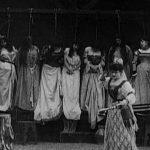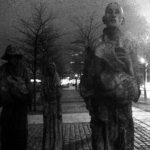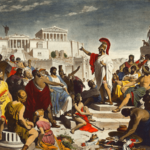In what could be considered a very bad idea, Robert Louis Stevenson trekked through Cevennes, France, among mountains and lower highlands, despite his youthful bad health, aboard a donkey named Modestine. It was the autumn of 1878 and he was many years, half a decade in fact, from the fame of his greatest literary success: Treasure Island. What did lend itself to a towering reputation was his embarking on the traditional grand tour of Victorian gentlemen, which explained his presence on top of a mountain range in the South of France, and it was no mean feat when he breached one of the highest ranges to make camp at a small clearing. After dining on chocolate, brandy, other delicacies that befit his social status, the budding writer made to kip in the sleep cap he carried with him under the day’s dying sun. But instead of embarking onto unforeseen travels in his dreams, his sleep was interrupted shortly after midnight.
Recommended Reading
The History of Christmas
Boil, Bubble, Toil, and Trouble: The Salem Witch Trials
The Great Irish Potato Famine
Waking to smoke a cigarette and enjoy the blissful silence of the bewitching hour, it was only after his wakeful contemplation that young Stevenson was able to return to his sleep. But not only did he forget about his sleep break, he also later recorded in his travel journey that “unknown to those who dwell in houses, when a wakeful influence goes abroad over the sleeping hemisphere, and all the outdoor world are on their feet.” Naming it his “perfect hour,” Stevenson continued that he felt delighted to be free from the “Bastille of civilization” and that his world had begun “afresh.” [1] What may have seemed like a simple sleep break did not appear to Stevenson that way, and he continued to ruminate on it’s origin and significance.
For Stevenson, the only difference in his sleeping pattern was that he was outdoors rather than in the confines of the city; and it caused him to wonder at the effect of the natural world on humanity. Was there some “thrill of mother earth below our resting bodies,” he wondered. “Even shepherds and country folk who are the deepest read in these arcana have not a guess as to the means or purpose of this nightly resurrections. Toward two in the morning they declare the thing takes place; and neither know or inquire further.” These new thoughts left him puzzled.
But unbeknownst to him, Stevenson had come upon the type of sleep that was commonplace among humanity prior to the modern era; where a wakeful hour or more of contemplation interrupted the blissful dreams of most Western Europeans, and not just those sleeping out under the stars. In fact, it was commonplace for people to wake up and complete tasks; either to smoke a cigarette, use the restrooms, or even converse with neighbors. This break between the “first sleep” and the second was time for thoughtful pondering on the earlier dreams of the night, even prayers, and were given great significance. In fact, these ruminations on early night sleep dreams lent themselves to the common superstition that dreams were somehow explanatory or predictive in and of themselves.
The sleep that we are more familiar with, which became commonplace after the rise of the Industrial Age and contains no midnight breaks for pondering, suggests that we spend less time contemplating our consciousness, and therefore are at a disadvantage to the interrupted, segmented slumber which expanded the minds of humanity prior to our race to mechanize.
Stevenson may have never known that he was making these claims, but the bare truth of the matter is this: have we lost some semblance of introspective in our attempts to get an uninterrupted night of sleep?
_________________________________________________________________
To examine this topic, we must take a magnifying glass to the world of sleep as it was for the early modern British society, with occasional references to elsewhere in the Western World, including Europe and the Americas. Although England makes the bulk of this inquiry, it is true that England was the standard for western society, even before the Industrial Revolution, where we begin our search for patterns. Without regard to the somewhat sparse references in scholarly articles to the sleeping habits of pre-industrial congregations, it is through the records of dreams that we are able to piece together the bedtime rituals, sleep deprivation, and differences between the sleeping practices of the different ranks of society. [2] And although this article will mainly focus on the incredible importance of sleep in everyday life, the more important, and more defined argument will be in the investigation of segmented sleep and it’s affect on early modern dreams.
The lack of proper documentation of sleep is in part due to the understanding that contemporaries of the time simply overlooked it’s need to be studied due to it’s commonplace nature in the everyday life of humans. We can, however, decipher some hints from medical journals, diaries, imaginative literature and legal depositions, who often reference sleep. And while it was often contemplated by many people of the time, for the thinkers of the age it took an easy backseat to the broader issues affecting class, religion, race, and gender of the age. It is only in the modern times that historians, scientists, scholars, and doctors have researched how individuals during the pre-industrial revolution dressed, bathed, ate, and slept, and that it has not only had a profound impact, but indeed a profound difference, in the way our sleep has changed throughout modern history. [3]
With the factories and mills exploded with excitement and industry, the imaginative literature of the age became obsessed with the idea of restful, peaceful sleep, drawing to contrast the marked difference between the life they lived during wakeful hours, and the ones lived in one’s dreams. The bed became, in poetry, prose, and drama, places of serenity, a “respite from thought,” a place that led to “happier regions.” [4] Not only did it provide a respite from working life, it also allowed for a break in the rigid social norms of the time, when rank, finance, and privilege reined in the British class system; all these could be escaped in sleep, and it was long thought during the time that those who escaped it more fully with slumber were those of the peasants, who had “simple minds” and therefore eased more fully into the peaceful realms of sleep than those of a higher position. [5]
But lying in these discoveries of the time’s idea of sleep lies the questions that define the age: did all social classes, despite theories of the time, enjoy the same kind of sleep? How did the nature of the life of the lower class affect their sleep, and therefore affect their station? And finally, was there a secret to what sleep provided people, other than the much deserved, much needed rest, of the body, and reprieve from everyday life?
_________________________________________________________________
Prior to the nineteenth century, little is known about the sleeping habits of the people; not the time at which they went to bed, nor the hour when they rose the next morning, or how their sleep varied throughout the night from one night to the next. It is only the understanding of light, and the expensiveness of candles, that it is assumed that many fled to their beds soon after sunset every night, and arose with the sun every morning. Because wealthier families had more opportunity to candles, their nighttime activities could vary greatly from most households of the time, who, at the appearance of darkness, stopped work and socialization. [6]
Physicians of the time followed the opinion of the Aristotelian belief that sleep originated in the abdomen as part of a digestive process called “concoction,” and therefore wrote of sleep as a credit to physical vitality, lively spirits and increased longevity for it’s role in the proces. In fact, “Bed as medicine” was a popular Italian proverb of the time, and contemporary thought was that retiring early would invoke the best benefits of sleep. [7,8]
At the same time however, contemporaries were known to look ill favorably on excess, saying it was cause for unnecessary sluggishness, that for the Puritanical Americans of the time, railed against as a mortal sin. [9] So what, in the end, predicated the perfect amount of sleep? Common among writers throughout the Continent urged a standard 6 to 8 hours of rest per night, unless under certain circumstances such as ill health, with some issuing seasonal adjustments to account for the longer summer daylight hours, and the short winter days. [10]
_________________________________________________________________
Cropping up in the popular literature of the age; from Shakespeare’s Macbeth and Henry V we see the preoccupation with rest of seven or eight hours rather than twelve, and the smaller numbers were what drew such fascination. Dreams however, became just one side study of sleep, for conditions such as narcolepsy and sleepwalking permeated newspapers as well as literary works. Such colloquialisms such as the Scottish saying “ye sleep like a dog in a mill, which indicated light and anxious sleep, or the Welsh aphorism “Men thrive by sleep, not long but deep”, referencing it is the continuity rather than the length that measure good sleep, became common phrases, even medical advice, for the community at large. [11]
Latest Society Articles
Who Invented Democracy? The True History Behind Democracy
Medieval Fashion: Tunics, Underclothes, Pointed Shoes, and More!
37 Underground Cities: The Hidden Pillars of Civilization
With the rising importance placed on sleep, the contraptions that humans used to sleep evolved as well, mainly bedroom furniture. English beds moved from straw pallets made directly on the floor to wooden frames outfitted with pillows, sheets, blankets, and “flock mattresses” which were typically filled with rags and stray pieces of wool. More affluent homes began the trend of decorative headboards, feather mattresses, and heavy curtains surrounding the bed to block out drafts or light that could disturb sleep throughout the night. Not only were better beds becoming things of social entitlement, but also greater comfort and better sleep. This rise in significance led to the trend that newlyweds purchase, or be gifted, a new bed as one of their first married possessions, and it was one of the first items to be read off in a will. In somewhat jest Carole Shammas has said that the early modern era could be renamed: “The Age of the Bed”, for it’s importance, and transformative power, on society. [12]
Once bedtime became a thing of sacredness, households became painstakingly compulsive toward anxieties that could potentially interrupt their slumber. Many thought threats to their body and soul lurked throughout the night over their defenseless bodies, or that darkness was indeed the shadow of Death come to take souls to the grave through the night. [13] Other thoughts that worried the sleeping were those of thieves breaking in to steal household possessions; they barred doors, locked shutters,and carried swords or firearms to bed with them to allay the common fears of the time. [14] Fleas and bedbugs were also feared as sleep interruptions, as well as drafts caused by open windows or too much moonlight, and nightcaps were worn to shield against the cold air.
Other traditions that unfolded throughout the nighttime fears were prayers said by the man of the household to calm nerves, the use of a candle as a “night light,” the washing of hair, bodies, and teeth prior to sleep, the use of medicine such as brandy or laudanum to aid sleeping or calm anxiety, and the discouragement of late night suppers so that digestion did not interrupt slumber.
While we may think of pre-modern slumber as significantly more peaceful than our own, due to their less complicated world, in fact the 17th century sleep was much more likely to be interrupted and therefore contain restlessness, troubles, and fear. [15] And more than that, the medical maladies of the time were far more severe on everyday life; everything from angina, gastric ulcers, rheumatoid arthritis, influenza, asthma, and tuberculosis (known during the time as consumption) caused pain and sensitivity throughout the night with little to no relief. The poor experienced even worse conditions, usually being susceptible to freezing temperatures, insects, and annoying noises. Often the urban populations slept in the streets, devoid of fireplaces or proper homes, on top of or beneath wooden platforms, haystacks, stables, barns, or where applicable, in caves. [16] Ordinary men and women of the population suffered from sleep deprivations, sleep debts, and ultimately chronic deprivation, that could attest to loss of motivation and physical well being among the masses, complicating everything from the common mood to social friction.
_________________________________________________________________
Until the end of the early modern era, Western Europe experienced two major intervals of sleep, separated by the hour of wakefulness Stevenson discovered on his adventure into the French countryside. The first sleep was often referred to as the “first sleep,” the “first nap” or “dead sleep.” [17] These terms were not only in English, but common in French, Italian, and Latin as well. And while Stevenson’s “nightly resurrection” has no common name, the term “watch” was coined by the Oxford English Dictionary to mean the “disinclination or incapacity for sleep.” The second of the sleep intervals was known as the “second” or the “morning sleep,” and both phases have been documented as lasting equal amounts of time, and for those falling asleep near sunset, it was common to experience the “watch” toward midnight and falling back asleep thereafter. So common was this sleep break that contemporaries felt little need to analyze it, and great writers of the time, including George Wither and John Locke, commented on it as a common feature of life, and despite minor disturbances throughout the night, the pattern of waking throughout the night was a customary division of night. [18]
In fact, many different parts of early modern society were aided by the break in sleep, or at least the result of it. Petty crime, theft, and burglary had opportunity if one or more hours of the night could be spent busy, many the echelons of high society extended their social hours to include the “watch,” and indeed it was suggested that fertility among laborers was increased due to the midnight wakefulness; men who came home physically exhausted were more likely to have enjoyment, and successful intercourse, if there was a rest period after the day’s troubles.
The effects of dreams on early modern society, which were pondered and pursued during the nighttime interval, were seen as informative of prospects as well as time’s past. While some visions were believed to be a reflection of nothing more than a sour stomach, other dreams carried divine prophecies and foreshadowed what was yet to come. In fact, there was a surging sale of dream books, entire compendiums, fortune teller books, devoted to translating different types of visions, that The Weekly Register in 1732 noted that “the English Nation has ever been famous for Dreaming.” [19] Ever a separation in the classes, dreaming among the poorer communities as see by playwrights and poets to soothe oppression and weariness, as well as provide the principal relief of drawing the poor out of their realities and into the independence of their souls and a daily escape from suffering, and in fact, in the Middle Ages, the Catholic Church believed doctrine that only monarchs and men of the church experienced dreams that were truly meaningful. However much dreams were part of pre-modern Western societies, the strength of their staying power has not endured as well as non-Western cultures, but were still important among British communities.
_________________________________________________________________
While it is an interesting note to view the pattern of broken sleep in context to the deeply religious nature of the early Christian and pre-Industrialized Europe—St. Benedict required his monks to rise after midnight and recite psalms, which spread throughout Germanic monasteries, and it was a common practice among Catholics in the High Middles Ages to pray in the quiet hours of the morning—the Christian teachings, and therefore Church as whole, was not responsible for the actual occurrence, just the time spent while awake. Indeed, historical writers such as Plutarch, Virgil, and Homer, as well as non-Western cultures that practiced beliefs other than Christianity, exhibited similarly segmented patterns of sleep. [20]
Therefore the very basis of the puzzle remains; the curious anomaly, and genuine mystery of segmented sleep prior to the Industrial Revolution is juxtaposed with today’s consistent sleep patterns, and it’s cause seems not to be rooted in Middle Age writings. True, many wild animals still exhibit the midnight wakefulness, giving us reason to believe that in humanity’s natural state our natural pattern of slumber includes this nightly watch, and has very little to do with sleeping outdoors.
One such explanation for the change in modern human’s sleeping patterns is the invention of modern lighting, and it’s psychological impacts on sleep. “Every time we turn a light,” says chronobiologist Charles A. Czeisler, “we are inadvertently taking a drug that affects how we sleep” with changes directly to the brain as one of the apparent consequences of light exposure. But scientists hardly believe that light is the only factor; sleeping conditions, boredom, forced rest, darkness, financial class, and many other such factors of the modern world are undoubtedly also parts of the equation.
Today we live in a world that is characterized by it’s never-ending nature; non-stop lights to follow our all-night television and radios, non-stop action with twenty-four hour gas stations and supermarkets, and non-stop entertainments that has become the primary time of employment for many growing sectors of Western work forces. Edison’s invention of mechanical light, and his theory that “put[ting] an undeveloped human being into an environment where there is artificial light and he will improve,” has carried past our sunsets and our sunrises and has increased the pace of our modern lives. In the United States alone, around 30 percent of adults average 6 hours or fewer hours of sleep at night, and many consider sleep itself to be a waste of time. [21]
The one takeaway, and remarkable implication, of the segmented sleep of our historical communities is that our modern, non segmented sleep and all of its destructiveness has been a modern invention of the last 200 hundred years, rather than scientific or cultural phenomenon of our ancestors.
Explore More Society Articles
The History of Asbestos
History of the Airplane
The History of Guns in American Culture
The Evolution of the Barbie Doll
History of Marijuana: Origins, Use, Effects, and More!
The Lives of Viking Women: Homesteading, Business, Marriage, Magic, and More!
Our dreams, however unimportant in our western culture, have been consolidated in our seamless sleep, and it is no small thing that by turning night into day with modern technology has increased our efficiency, but perhaps has also obstructed one of the oldest avenues of the human psyche for self awareness and personal growth.
Perhaps more than just the lack of hours, that is, perhaps, the biggest loss; to be “disannulled of our first sleep, and cheated of our dreams and fantasies,” as paraphrased by Thomas Middleton. [22]
READ MORE: The History of Working from Home
Resources
- Robert Louis Stevenson, The Cevennes Journal: Notes on a Journey through the French Highlands,Gordon Golding, ed. (New York, 1979), 79–82.
- Samuel Johnson, The Adventurer (March 20, 1753): 229. Nearly twenty years ago, George Steiner argued that studies of sleep “would be as essential, if not more so, to our grasp of the evolution of mores and sensibilities as are the histories of dress, of eating, of child-care, of mental and physical infirmity, which social historians and the historiens des mentalités are at last providing for us.” “The Historicity of Dreams,” in Steiner, No Passion Spent: Essays 1978–1996 (London, 1996), 211–12. More recently, Daniel Roche has implored, “Let us dream of a social history of sleep.” A History of Everyday Things: The Birth of Consumption in France, 1600–1800, Brian Pearce, trans. (Cambridge, 2000), 182. Historical accounts of dreams have included Peter Burke, “L’histoire sociale des rêves,” Annales: E.S.C.28 (1973): 329–42; Richard L. Kagan, Lucrecia’s Dreams: Politics and Prophecy in Sixteenth-Century Spain (Berkeley, Calif., 1990); Steven F. Kruger,Dreaming in the Middle Ages (Cambridge, 1992); Carole Susan Fungaroli, “Landscapes of Life: Dreams in Eighteenth-Century British Fiction and Contemporary Dream Theory” (PhD dissertation, University of Virginia, 1994); Alan Macfarlane, The Family Life of Ralph Josselin, a Seventeenth-Century Clergyman (Cambridge, 1970), 183–87; S. R. F. Price, “The Future of Dreams: From Freud to Artemidorous,” Past and Present 113 (November 1986): 3–37; Manfred Weidhorn, Dreams in Seventeenth-Century English Literature (The Hague, 1970); Dream Cultures: Explorations in the Comparative History of Dreaming, David Shulman and Guy G. Stroumsa, eds. (New York, 1999); Charles Carlton, “The Dream Life of Archbishop Laud,” History Today 36 (December 1986): 9–14. Attitudes toward sleep, from the ancient world to the twentieth century, are chronicled in Jaume Rosselló Mir, et al., “Una aproximacion historica al estudio cientifico de sueño: El periodo intuitivo el pre-cientifico,” Revista de historia de la psicologia12 (1991): 133–42. For a brief survey of sleep in the Middle Ages, see Jean Verdon, La nuit au Moyen Age (Paris, 1994), 203–17; and for an examination of key medical texts touching on sleep during the early modern era, see Karl H. Dannenfeldt, “Sleep: Theory and Practice in the Late Renaissance,”Journal of the History of Medicine 41 (October 1986): 415–41.
- Charles Gildon, The Post-Boy Rob’d of His Mail . . .(London, 1692), 109.
- Johnson, Adventurer (March 20, 1753): 232. Among poets, Christof Wirsung echoed, sleep represented “the pleasantess amongst all goods, yeas the onelie giver of tranquility on earth.” Praxis Medicinae Universalis: or, A Generall Practise of Phisicke . . .(London, 1598), 618. See also Albert S. Cook, “The Elizabethan Invocations to Sleep,” Modern Language Notes 4 (1889): 457–61.
- Works of John Taylor the Water Poet Not Included in the Folio Volume of 1630, 5 vols. (1870; rpt. edn., New York, 1967), vol. 1. For the “sommeil du juste,” see Verdon, La nuit au Moyen Age, 203–06. Earlier, the belief that “the sleep of a labouring man is sweet” was expressed in Ecclesiastes 5:12. See alsoDu Bartas: His Divine Weekes and Workes, Joshua Sylvester, trans. (London, 1621), 465; Robert Daborne, The Poor-Mans Comfort (London, 1655); John Collop, “On Homer,” in Poesis Rediviva(London, 1656), 63; Cheesman, Death Compared to Sleep, 12; William Somervile, Ocassional Poems, Translations, Fables, Tales . . . (London, 1727), 275; “The Peasant,” General Advertiser (London), November 16, 1751; ballad quoted in Carl Bridenbaugh, Vexed and Troubled Englishmen: 1590–1642 (New York, 1968), 84.
- Thomas Middleton, A Mad World, My Masters . . .(London, 1608). For a sampling of this belief, see Pierre Goubert, The French Peasantry in the Seventeenth Century, Ian Patterson, trans. (Cambridge, 1986), 39; Jacques Wilhelm, La vie quotidienne des Parisiens au temps du Roi-Soleil, 1660–1715 (Paris, 1977), 70; Maria Bogucka, “Work, Time Perception and Leisure in an Agricultural Society: The Case of Poland in the Sixteenth and Seventeenth Centuries,” in Labour and Leisure in Historical Perspective, Thirteenth to Twentieth Centuries, Ian Blanchard, ed. (Stuttgart, 1994), 50; Barbara and Cary Carson quoted in James P. Horn, Adapting to a New World: English Society in the Seventeenth-Century Chesapeake(Chapel Hill, N.C., 1994), 315; David D. Hall, Worlds of Wonder, Days of Judgment: Popular Religious Belief in Early New England (New York, 1989), 214.
- Henry Davidoff, A World Treasury of Proverbs from Twenty-Five Languages (New York, 1946), 25. See, for example, Levinus Lemnius, The Touchstone of Complexions . . ., T. Newton, trans. (London, 1576), 57; John Northbrooke, A Treatise wherein Dicing, Dauncing, Vaine playes or Enterluds with Other Idle Pastimes . . . (London, 1577), 8; William Vaughan,Naturall and Artificial Directions for Health . . .(London, 1607), 53; The Workes of That Famous Chirurgion Ambrose Parey, Thomas Johnson, trans. (London, 1649), 26–27; Henry Hibbert, Syntagma theologicum . . . (London, 1662), 282; Dannenfeldt, “Sleep,” 407–12.
- John Trusler, An Easy Way to Prolong Life, By a Little Attention to Our Manner of Living . . . (London, 1775), 11. How widespread this notion was may be seen in such proverbs as “go to Bed with the lamb and rise with the lark” and “would you have a settled head, You must early go to bed.” Morris Palmer Tilley, A Dictionary of the Proverbs in England in the Sixteenth and Seventeenth Centuries(1950; rpt. edn., Ann Arbor, Mich., 1966), 36.
- Baxter quoted in Stephen Innes, Creating the Commonwealth: The Economic Culture of Puritan New England (New York, 1995), 124; Thomas Elyot,The Castle of Helthe (London, 1539), fols. 45–46;The Schoole of Vertue, and Booke of Good Nourture . . . (London, 1557); William Bullein, A Newe Boke of Phisicke Called y Goveriment of Health . . . (London, 1559), 91; Andrew Boorde, A Compendyous Regyment or a Dyetary of Health . . . (London, 1547); Michael Cope, A Godly and Learned Exposition uppon the Proverbes of Solomon, M.O., trans. (London, 1580), fols. 85, 415v–16; Lemnius, Touchstone of Complexions, 58; Northbrooke, Treatise, passim; Sir Thomas Overbury, The “Conceited Newes” of Sir Thomas Overbury and His Friends, James E. Savage, ed. (1616; rpt. edn., Gainesville, Fla., 1968), 167; The Whole Duty of Man . . . (London, 1691), 188–89; Richard L. Greaves, Society and Religion in Elizabethan England (Minneapolis, 1981), 385–87.
- Bullein, Newe Boke of Phisicke, 91; Boorde,Compendyous Regyment; Venner, Via recta, 279–80;Directions and Observations relative to Food, Exercise and Sleep (London, 1772), 22; Dannenfeldt, “Sleep,” 430.
- William Rowley, All’s Lost by Lust (London, 1633); Thomas Shadwell, The Amorous Bigotte (London, 1690), 43; The Dramatic Works of Sir William D’Avenant (New York, 1964), 146; Boswell, [“On Sleep and Dreams”], 2: 112; Henry Vaughan, Welsh Proverbs with English Translations (Felinfach, Wales, 1889), 35; Erik Eckholm, “Exploring the Forces of Sleep,” New York Times Magazine (April 17, 1988): 32.
- William Harrison, The Description of England,Georges Edelen, ed. (Ithaca, N.Y., 1968), 201; Lemnius, Touchstone of Complexions, 73; Stephanie Grauman Wolf, As Various as Their Land: The Everyday Lives of Eighteenth-Century Americans(New York, 1993), 66; Carole Shammas, “The Domestic Environment in Early Modern England and America,” Journal of Social History 14 (Fall 1990): 169, 158; F. G. Emmison, Elizabethan Life: Home, Work and Land (Chelmsford, Eng., 1976), 12–15; Pounds, Culture of the English People, 145–47; Flandrin, Families in Former Times, 102; Daniel Roche, The People of Paris: An Essay in Popular Culture in the 18th Century, Marie Evans, trans. (Leamington Spa, Eng., 1987), 130–31; Roche,History of Everyday Things, 182–85; Robert Jütte,Poverty and Deviance in Early Modern Europe(Cambridge, 1994), 69–70; Pardailhé-Galabrun,Birth of Intimacy, 73–81. Anthony Burgess interpreted the elevated height of bedsteads “as a symbol of overlordship” for which there was “no utilitarian rationale.” Not only did raised beds remain accessible to vermin, but it was “easier for your enemies to stab you than if you were on the floor.” Burgess, On Going to Bed (New York, 1982), 84. To be sure, the height of bedsteads dramatically distinquished men and women of property from other household members, including children confined to trundle beds and servants, but my experience as a graduate student without the benefit of a bedstead makes me skeptical that persons found it no more comfortable to enter and exit a raised bed. Moreover, medical opinion warned against resting “upon the ground, nor uppon colde stones, nor neere the earth: for the coldnesse of stones, and the dampe of the earth, are both very hurtfull to our bodies.” Cogan, Haven of Health,235. See also Steven Bradwell, A Watch-man for the Pest . . . (London, 1625), 39.
- Boswell, [“On Sleep and Dreams”], 2: 110; Richard Steele, The Husbandmans Calling: Shewing the Excellencies, Temptations, Graces, Duties, etc. of the Christian Husbandman (London, 1670), 270. “We are unable to think of, much more to provide for, our own Security,” observed the eighteenth-century poet James Hervey. Meditations and Contemplations, 2 vols. (London, 1752), 2: 42. See also Stephen Bateman, A Christall Glasse of Christian Reformation . . . (London, 1569); Thomas Amory, Daily Devotion Assisted and Recommended, in Four Sermons . . . (London, 1772), 15; Benjamin Bell, Sleepy Dead Sinners (Windsor, Vt., 1793), 8. For Sigmund Freud’s influential discussion of “neurotic ceremonials” pertaining to sleep, see “Obsessive Actions and Religious Practices,” in The Standard Edition of the Complete Psychological Works of Sigmund Freud, James Strachey, ed., 23 vols. (London, 1957–66), 9: 117–18; Barry Schwartz, “Notes on the Sociology of Sleep,” Sociological Quarterly 11 (Fall 1970): 494–95; Stanley Coren,Sleep Thieves: An Eye-Opening Exploration into the Science and Mysteries of Sleep (New York, 1996), 165.
- See, for example, September 8, 11, 1794, Diary of Elizabeth Drinker, 1: 590, 592; December 2, 1766, and February 8, 1767, The Blecheley Diary of the Rev. William Cole, 1765–67, Francis Griffin Stokes, ed. (London, 1931), 161, 184; The Justiciary Records of Argyll and the Isles, 1664–1742, John Cameron and John Imrie, eds., 2 vols. (Edinburgh, 1949, 1969), 2: 466; Old Bailey Sessions Papers, May 19–20, 1743, December 5–9, 1746; Deposition of Mary Nicholson, February 20, 1768, Assi 45/29/1/169.
- Herbert’s Devotions: or, A Companion for a Christian . . . (London, 1657), 1. See also, for example, Edmund Spenser quoted in Deverson, Journey into Night,133; Quarles, Complete Works, 2: 206; October 12, 1703, Cowper Diary; Lady Charlotte Bury, The Diary of a Lady-in-Waiting, A. F. Steuart, ed., 2 vols. (London, 1908), 1: 31; Richard Brathwait, Natures Embassie: or, The Wilde-mans Measvres (London, 1621), 120; Thomas Shadwell, The Miser (London, 1672), 18; George Powell, The Imposture Defeated: or, A Trick to Cheat the Devil (London, 1698), 28; April 4, 1782, Journal of Peter Oliver, Egerton Manuscripts, British Library, London; Benjamin Mifflin, “Journal of a Journey from Philadadelphia to the Cedar Swamps&Back, 1764,” Pennsylvania Magazine of History and Biography 52 (1928): 130–31. The supplement to Denis Diderot’s Encyclopédieidentified numerous obstacles to sleep: “Hunger prevents sleeping, indigestion, any irritating cause that constantly agitates some part of the body, the cold in one part of the body, feet for example, while the rest is covered, violent sounds, anxieties&annoyances, a preoccupation, melancholy, mania, pain, shiverings, warm drinks, drunk from time to time, like tea, coffee, several diseases of the brain that are not yet well determined, all these prevent sleep.” Supplément a L’Encyclopédie, ou, Dictionnaire raisonné des sciences, des arts et des métiers . . . , 4 vols. (1777; rpt. edn., New York, 1969), 4: 809. For an extended discussion of sleep disturbances, see Ekirch, At Day’s Close.
- William Hill quoted in Menna Prestwich, Cranfield: Politics and Profits under the Early Stuarts (Oxford, 1966), 529; Bridenbaugh, Vexed and Troubled Englishmen, 13; Collected Works of Oliver Goldsmith, 1: 432; A. L. Beier, Masterless Men: The Vagrancy Problem in England, 1560–1640 (London, 1985), 83–84; Jütte, Poverty and Deviance, 69–70; Legg, Low-Life, 18. “Bulkers” are mentioned in theOld Bailey Sessions Papers, July 5, 1727; Legg, Low-Life, 99; Grose, Dictionary of the Vulgar Tongue; Lance Bertelsen, The Nonsense Club: Literature and Popular Culture, 1749–1764 (Oxford, 1986), 29.
- For the term “first sleep,” I have discovered sixty-three references within a total of fifty-eight different sources from the period 1300–1800. See below in the text for examples. “First nap” appears in Colley Cibber, The Lady’s Last Stake: or, The Wife’s Resentment (London, 1708), 48; Tobias George Smollett, The Adventures of Ferdinand Count Fathom, 2 vols. (London, 1753), 1: 73; Emily Bronte,Wuthering Heights, Ian Jack, ed. (Oxford, 1981), 97. For “dead sleep,” see Geoffrey Chaucer, The Canterbury Tales (Avon, Conn., 1974), 93; Henry Roberts, Honurs Conquest (London, 1598), 134; Rowley, All’s Lost by Lust; Thomas Randolph, Poems with the Muses Looking-glasse . . . (Oxford, 1638); Shirley James, The Constant Maid (London, 1640); Robert Dixon, Canidia: or, The Witches . . . (London, 1683), 6. The fewer references to segmented sleep I have found in early American sources suggests that this pattern, though present in North America, may have been less widespread than in Europe, for reasons ranging from differences in day/night ratios to the wider availability of candles and other forms of artificial illumination in the colonies. Two sources—Benjamin Franklin, “Letter of the Drum,”Pennsylvania Gazette (Philadelphia), April 23, 1730, and Hudson Muse to Thomas Muse, April 19, 1771, in “Original Letters,” Willam and Mary Quarterly 2 (April 1894): 240—contain the expression “first nap.” I have also found references to segmented sleep in twelve works of American fiction published during the first half of the nineteenth century. All the stories take place either in America or in Europe, with nearly half set before 1800. See, for example, Washington Irving, The Beauties of Washington Irving . . . (Philadelphia, 1835), 152; Irving, A Book of the Hudson . . . (New York, 1849), 51; Irving, Bracebridge Hall, Tales of a Traveller, The Alhambra (New York, 1991), 398, 813; Richard Penn Smith, The Forsaken: A Tale, 2 vols. (Philadelphia, 1831), 2: 211; James Fenimore Cooper, The Ways of the Hour (New York, 1850), 276; Nathaniel Hawthorne, Tales and Sketches: A Wonder Book for Girls and Boys, Tanglewood Tales for Girls and Boys,Roy Harvey Pearce, ed. (New York, 1982), 293. While visiting London one winter, Hawthorne, in fact, noted a difference in the nature of English nights and sleep from his own experience in New England: “At this season, how long the nights are—from the first gathering gloom of twilight, when the grate in my office begins to grow ruddier, all through dinnertime, and the putting to bed of the children, and the lengthened evening, with its books or its drowsiness,—our own getting to bed, the brief awakenings through the many dark hours, and then the creeping onward of morning. It seems an age between light and light.” January 6, 1854, Hawthorne, The English Notebooks (New York, 1962), 44.
- George Wither, Ivvenila (London, 1633), 239; John Locke, An Essay Concerning Human Understanding(London, 1690), 589. See also Francis Peck,Desiderrata curiosa: or, A Collection of Divers Scarce and Curious Pieces . . . , 2 vols. (London, 1732), 2: 33. For references to the “first sleep” of animals, see, for example, James Shirley, The Constant Maid (London, 1640); Samuel Jackson Pratt, Harvest-Home . . . , 3 vols. (London, 1805), 2: 457; Caroline Matilda Kirkland, A New Home . . .(New York, 1839), 140.
- The Weekly Register: or, Universal Journal (London), December 30, 1732; “Somnifer,” Public Advertiser,October 24, 1767. For dream books, see, for example, Nashe, “Terrors of the Night,” 1: 369–70;The Art of Courtship: or, The School of Delight . . . as Likewise the Interpretation of Dreams ([London], 1686); Nocturnal Revels: or, A Universal Dream-Book . . . (London, 1706); “Somniculus,” Worcester Journal, December 21, 1744; Lilly, Groatsworth of Wit; Chap-Books of the Eighteenth Century, John Ashton, ed. (New York, 1966), 81–82; Price, “Future of Dreams,” 32.
- F. G. Moore, Livy, 6: 372–73; Virgil, The Aeneid,Robert Fitzgerald, ed., John Dryden, trans. (New York, [1965]), 43; Pausanias, Description of Greece,W. H. S. Jones and H. A. Ormerod, trans., 5 vols. (Cambridge, 1966), 2: 311; Plutarch, The Lives of the Noble Grecians and Romans, John Dryden, trans. (New York, 1979), 630, 1208; Chapman’s Homer: The Iliad, The Odyssey and the Lesser Homerica,Allardyce Nicoll, ed., 2 vols. (Princeton, N.J., 1967), 2: 73.
- Patricia Edmonds, “In Jampacked Days, Sleep Time Is the First to Go,” USA Today, April 10, 1995. See also Avi Sadeh, et al., “Sleep Patterns and Sleep Disruptions in School-Age Children,” Developmental Psychology 36 (May 2000): 291–301. Ironically, we might be less willing to shortchange our time in bed were the quality of modern sleep worse. Despite periodic complaints of insomnia, our sleep today far excels the fitful slumber characteristic of past centuries. At least in the Western world, no longer does the sleep of such large numbers of people fall prey to periodic pain, frigid temperatures, and voracious pests, among other early modern maladies. But if not the quality, then the quantity of our sleep continues to diminish.
- ehr, “Impact of Changes in Nightlength,” 283; Wehr, “‘Clock for All Seasons,’” 339; Joseph Lawson, Letters to the Young on Progress in Pudsey during the Last Sixty Years (Stanningley, Eng., 1887), 73; Thomas Middleton, “The Black Book,” inThe Works of Thomas Middleton, A. H. Bullen, ed., 8 vols. (1885; rpt. edn., New York, 1964), 8: 14; Dotto,Losing Sleep, 36. Roger Bastide has written, “In our Western civilization, however, the bridges between the diurnal and nocturnal halves of man have been cut. Of course, people can always be found—and not only in the lower classes of society—who consult dream books, or who at least examine their dreams and assign to them a role in their lives. But such vital functions of the dream remain personal and never become institutionalized. On the contrary, far from constituting regularized norms of conduct they are considered aberrant; they are classed as ‘superstitions’; sometimes it is even suggested that people who look for significance or direction in dreams are not entirely all there.” Bastide, “The Sociology of the Dream,” in Gustave Von Grunebaum, ed., The Dream and Human Societies(Berkeley, Calif., 1966), 200–01.











